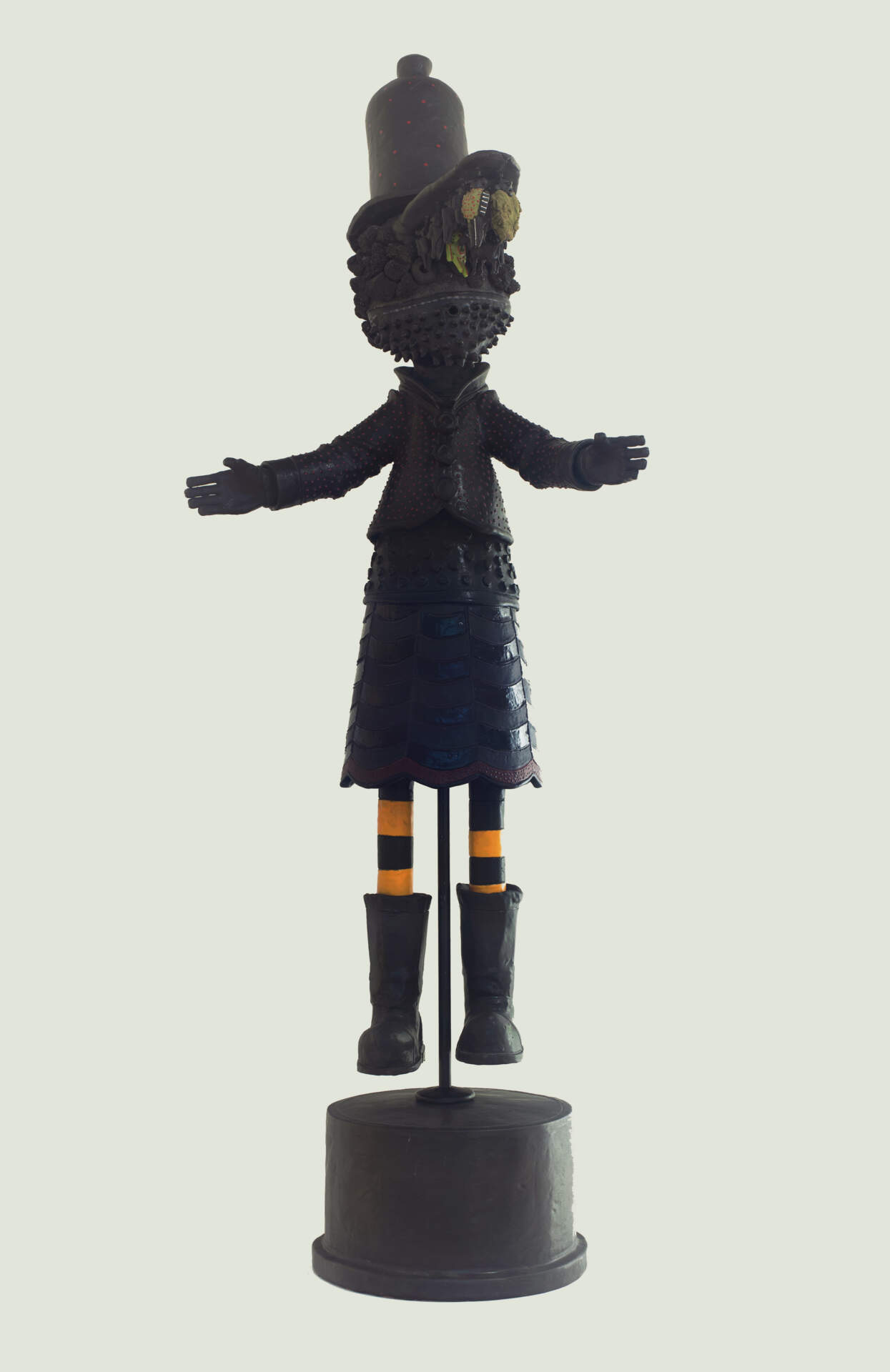Bill Stewart (1941-2020)Elder’s Striped Socks
2013
terra cotta, glaze, mixed media
74 x 27 x 16 inches
Collection of the Burchfield Penney Art Center, Gift of the artist, 2019
Elder’s Striped Socks, also known as The Elders New Socks (2013), is a shaman sculpture by the renowned artist Bill Stewart that was first exhibited at the Burchfield Penney Art Center in Art in Craft Media 2015, and shown in Where I’ve Been at Indigo Art in Buffalo (May 3-July 6, 2019). The Burchfield Penney Art Center has several works by Stewart in the collection, and welcomed the generous donation of a major shaman sculpture when the artist and his wife, Bonnie, relocated to the Hudson Valley. In 2011, Nancy Weekly wrote a review for Ceramics Monthly about the Indigo exhibition, Shaman: Recent Work by Bill Stewart. It did not get published, but Indigo printed it for the exhibition, Where I’ve Been, a collection of work by Bill Stewart (on view May 3-July 6, 2019), which is shared below:
"Shaman: Recent Work by Bill Stewart"
In cultures all over the globe, people respect shamans as healers and intermediaries who can provide spiritual guidance. The shaman connects with the natural world, often evoking the spiritual essence of the landscape, as well as living creatures and humans. He or she might facilitate a “journey” or out-of-body experience, remove negative energy through incantations, or conjure up animal spirits as human protectors. Each individual receives a unique resolution for the initial problem during the shaman’s communication mediation.
Through the ceramic sculpture of Bill Stewart, we can see that the mystical powers of shamans are as complex and unfathomable as they are diverse. His nationally acclaimed work is simultaneously humorous and intriguing, while also being mystifying and daunting. Over the course of his career, Stewart has created playful, expressionistic clay figures which frequently have both human and animal characteristics. Cyclically, they have been monochromatic, then wildly colorful. Either way, they are always texturally intricate and patterned on two- and three-dimensional planes.
The scale of Stewart’s Shaman series has its roots in The Council, a commissioned installation for the Greater Rochester International Airport completed in 1991. It is comprised of a bird and five masked or animal-headed figures that stand as tall as 10 feet high in a granite pool of water. They are covered in a matte black glaze with some white detailing. To emphasize the connection between humans and animals as articulated in Native American beliefs, Stewart had excerpts from an Inuit hunting song and Chief Seattle’s treaty oration to Congress in 1854 engraved in the pool’s base.
Stewart’s first Shaman, now in the collection of the Burchfield Penney Art Center at Buffalo State College, incorporates motifs from Native American, African and Egyptian art, blended with contemporary pop culture. The Shaman series Stewart recently developed and exhibited at the Indigo Gallery in Buffalo, New York, evokes an amusing, benevolent, yet surreal fantasy world as characters derived from artifacts, the circus, toys, comics, costumes, ancient art and internationally diverse religious iconography, including Catholicism and scarification rituals.
The new Shamans and other figures(2009-2010) stand up to 80 inches tall, displayed on stands like giant dolls or votives so that their feet float a few inches above each base. Most wear long skirts covered with relief patterns, such as skulls on Witch whose wizened, warty, bearded old man’s head supports a Christian bishop’s mitre embellished with more skulls. Chief Seattle with hands raised in gestures of benevolence is countered by Cowboy who raised his handgun skyward. Many of the other figures are masked, their identities obscured—especially The Sorcerer, whose visage is even more disguised by an assortment of dolls and animals than the hidden portraits painted by the 16th century Italian master, Giuseppe Arcimboldo.
Each Stewart sculpture invites interpretation of its myriad components. What meaning is implied in the juxtaposition of parts? In addition, Stewart also references the rich history of international ceramics, such as Pre-Columbian black terra cotta vessels and figurally ornamented African earthenware ritual vessels and lidded pots. From more recent history, one can discern characters reminiscent of the Beatles’ Yellow Submarine and Walt Disney animations, as well as the ubiquitous rubber ducky. Colorful embellishments and textural patterns summon the exoticism of West African masquerades in which priests and priestesses are transformed into surreal beings that merge plant, animal and human realms.
While not divulging all the details, Stewart nonetheless has stated his salient concerns:
I have been using the practical, spiritual, emotional and psychological history of tools, toys and body-adornment as source material. These images are comments on human evolution relative to environmental and spiritual issues and development. The basic image is preplanned (observed), parts are produced and assembled, but an aggressive, intuitive thought process is forced on the imagery and eventually pushes the limitations of the medium, attempting to eliminate any constraints on the imagination. (Bill Stewart in Contemporary Ceramics by Susan Peterson. New York: Watson-Guptill Publications, 2000: 174.)
Bill Stewart’s large-scale Shaman series exists in a mythological time—representing a timeless human relationship with spiritual qualities of nature. — Nancy Weekly, Head of Collections and Charles Cary Rumsey Curator, Burchfield Penney Art Center
